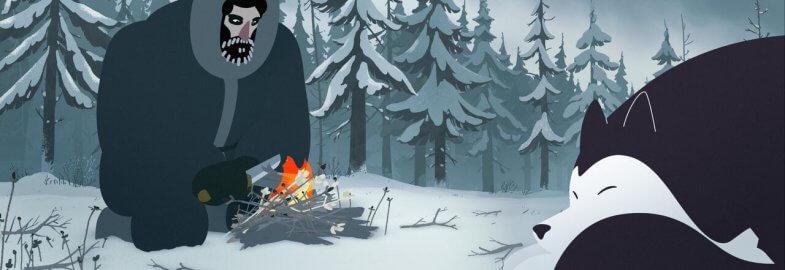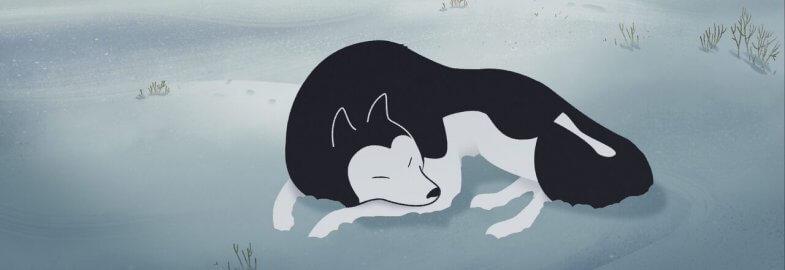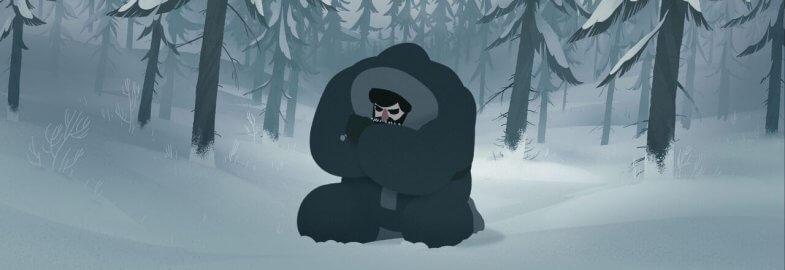Interview with Nexus director Fx Goby (“To Build A Fire”)
UPDATE (13/12/2017): To Build A Fire is now available to watch online in full (stream below)
Last year, to mark one hundred years passing since the death of pioneering American writer Jack London, Nexus Productions and Composite Films released their stunning animated adaptation of his 1908 short story To Build A Fire. Helmed by director Fx Goby (whose work for the company spans short films, music videos and numerous high profile projects for clients such as Coca-Cola and Google), the film has been screened internationally at festivals including Anima Mundi, Aesthetica, KLIK!, Animaze, 3D Wire, Cinanima and Anibar as well as winning major awards including Best Animation at London Short Film Festival, Shorts Mexico and the Oscar-qualifying Rhode Island Film Festival.
Originally hailing from Grasse in France, Fx graduated from the CG animation institution Supinfocom with his award-winning student film En Tus Brazos, ultimately joining Nexus as a director following its strong performance and going on to direct the live-action B-movie tribute The Elaborate End of Robert Ebb.
With gorgeously-rendered visuals and a haunting score by Mathieu Alvado, the film has wowed animation and Jack London enthusiasts alike over the past year. Ahead of a special Skwigly Screening of To Build A Fire as part of this year’s Manchester Animation Festival, we caught up with Fx Goby to learn more about taking on a true classic of American literature.
Can you tell us a bit about your animation background leading up to your current position as an animation director?
I started making films with my friends when I was 10 – mostly horror films with a lot of ketchup. I then discovered Wallace and Gromit and realised how cool animation was. So I made my first stop-motion films at 13, pretty terrible things, but I loved how rewarding it was to film something frame by frame, static, and how it would become alive in the end! So I decided I wanted to make films and applied to many film schools but only got into an animation school called Supinfocom at the time. I learned how to make CG films and graduated with a short film En tus Brazos. That allowed me to start working as a director as soon as I came out of school.
What had your prior working relationship been with Nexus and Composite when To Build A Fire came around – and what respective roles did the companies play as far as the film’s production went?
I have been working with Nexus for 8 years as a director, and together we’ve done all sort of projects – films, animations, advertising, installations, interactive stories, music videos, etc. Composite Films is a production company created by my friend Sam working mostly on documentaries, but he had an appetite for making an animated short and knew I wanted to adapt To Build a Fire by Jack london. Nexus immediately jumped on it and co-produced the film with us, Composite finding the funds and Nexus offering the studio and the logistics! It was a great match and a super pleasant experience.
I gather crowdfunding played a role in making sure production costs were met – did you have much direct involvement in the campaign (and if so do you have any thoughts/advice for those who might pursue a similar funding route)?
I was entirely involved in the crowdfunding and it is draining. It is hard to crowdfund a film because, unlike people looking to crowdfund the production of an object (shoes, bikes etc…), ultimately the perks you get on a film are pretty lame: A DVD (who uses those anymore?), a t-shirt etc…
So you can only count on people that really want to help make a film; philanthropists. I guess people are now more used to crowdfunding, which is good because they are less scared to participate, but more and more we become numb to all those projects that need us to chip in. It’s a great way to promote a film-to-be and to launch it with energy but we managed to gather 25K which represents a piece of sand in what is needed to make a film that takes months!
Can you talk through the visual development of the film and what ultimately determined it be rendered using 2D animation?
Originally I planned filming the story but realised it would be extremely challenging. Also I started to think that 2D animation would force me to simplify and allow me to create strong and striking visuals, working on the silhouette of the character and limiting the colour palette. So I teamed up with Tristan Menard, an amazing art director who helped me create the look of the landscape, the third character of the film. I wanted it to feel cold in the most limited way possible, avoiding any unnecessary elements that are not essential to the story, to make it as pure and neat as we could. He was amazing.
Roughly how long did the production last, and was it made alongside other work or were you able to give it your sole focus?
It took 9 months from start to finish (excluding the pre-production storyboard and animatic). The clean-up was a tough process brilliantly led by a student from the Arts University Bournemouth, David Blanche, who worked countless hours to make sure the film was perfectly made.
It was released in the centenary year of Jack London’s death – had it been commissioned to commemorate the event or was that a personal goal you were working toward?
We just thought it would be nice for us to have a deadline. It happened to match our timings so we did it this way! This film was shown in a commemoration of London in Dawson City in the Yukon, with his great-granddaughter, and she liked the film!
What significance – if any – did the original Jack London story have to you personally?
I read it when I was a boy scout, loving being in nature and camping. It taught me a lot about how magnificent and dreadful Nature can be. I always thought that London had a very cinematic talent in his writing and thought this would make a wonderful film!
Were any of Jack London’s other works contemplated as possible stories to adapt?
Yes of course. He is known for his incredible novels about nature, The Call of the Wild and White Fang, but he has done some highly political novels too, some that are still relevant today about the working class. Unfortunately he also lost himself and wrote some highly controversial novels and articles later in his career.
Were there any challenges – or liberties taken – in adapting the story to an animated short?
I had to cut it shorter. The hardest part was that I wanted the novel to be translated into sound and images, but with the least words possible. I was interested in a real adaptation, where London’s beautiful words would be replaced by strong audiovisual storytelling. It was hard, because London describes everything in details; the omniscient narrator can observe the slow relentless fall of the character by describing his thoughts and actions, commenting on his intentions – lots of things that we cannot do easily in films unless we use a narrator. My challenge was to convey those emotions in the staging and in the animation. So I sometimes had to make choices where certain things might not look clear, but making sure people feel what they need to feel.
Has there been any feedback or critical responses from London’s own audience about the film, and if so has this differed in any ways from the response you’ve gotten from general animation audiences?
I have had amazing responses, much better than I could have hoped for. London lovers are usually very happy with this adaptation because it is the same story but entirely revisited in a way that was never done before. Many adaptations have used the narrator commenting on what we can see on the screen, it creates a sort of heavy, boring redundancy, that I wanted to avoid absolutely. So this film complements well the novel in that sense. Recently I met Michaël Dudok de Wit (The Red Turtle) and he said he found the film to be strong, and hard to adapt from such a strong novel. I was beyond happy!
There’s a tremendous tension that builds around the character’s increasing sense of self-inflicted peril. How much of that would you say is owed to the pacing of the animation, and what did that process entail to get it right?
I approached this as a film. I love films that dare to take their time, stay a bit too long on certain shots, it makes the audience feel uncomfortable. I have a shot that lasts 1min45s, it is very rare in animation to do that because it is hell to animate. But I really wanted the tension to be present from the first shot and invisibly rising throughout. Animation is pace and the animators understood that this film needed to take time, not in a boring way, but to allow the building of tension from tiny, minute details, up to the unavoidable tragedy.
We’ve recently spoken with Mathieu Alvado about his perspectives on being involved as a composer. What brought him to your attention originally as a fit for the project?
Mathieu is a genius composer, capable of creating some huge, popcorn movie soundtracks, intimate scores, or dramatic ones. We met a few years back when he created the music for a short film mixing a musical and monster-movie references. The score was amazing and orchestral and I thought that I would love to work with him. He is a genius really, he has so many great ideas. He really loves films too, so he has a perfect understanding of how music works with images. I am now working on an super great 360 film with him at the moment and again he did an incredible score!
From your point of view can you talk through how you worked together to perfect the music?
Mathieu created the soundtrack from the animatic I gave him. I wanted the music to be the voice of nature, the third character of the film after the trapper and the dog. He created a wonderful melody and originally had a high flute as a solo. I thought this sounded too fragile and wanted a sound that would feel a bit rounder and stronger and he decided to go for a bass flute, a very unusual texture. It was a brilliant idea and totally changed the sound and feel! But in all truth I had very little to change, the whole score was incredible!
The environment art is stunning and another crucial contributor to the atmosphere of the film. Can you talk a bit about your working process with the film’s production designer and artists to achieve the final look of the film?
As I mentioned before we worked with Tristan Menard to create the backgrounds. There was a lot of back and forth, deciding if we were going to have realistic tones, sunlight, senses or not – how to create the cold, how to make a graphic language that is stylised and still, somehow, organic.
Previous films of yours have combined animation and live-action to great effect – is this mixed-media approach something you’d return to in your film work?
I am now reaching a point where I have tried all sorts of techniques, not because I want to tick boxes in a never ending bucket list, but because I just want to use the best approach depending on the story I want to tell. Right now I am exploring what it is to do a 360 degree VR film, and this is very challenging as a director, because I am losing control on frame and time, by letting the audience choose. I love exploring and trying new things and will never rule out a technique just because I don’t know it yet!




